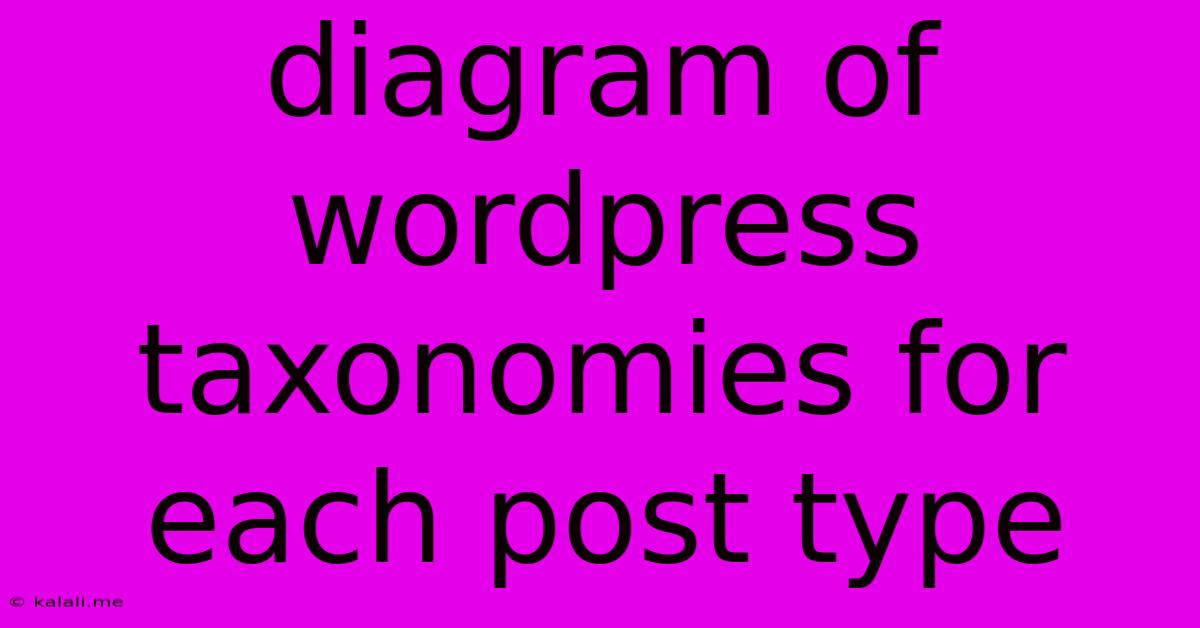Diagram Of Wordpress Taxonomies For Each Post Type
Kalali
May 23, 2025 · 3 min read

Table of Contents
Understanding WordPress Taxonomies: A Diagrammatic Guide for Each Post Type
WordPress, while incredibly user-friendly, boasts a powerful underlying structure. Understanding this structure, especially concerning taxonomies, is crucial for optimizing your website's content organization and SEO. This article provides a clear diagrammatic representation of how taxonomies work with various WordPress post types, clarifying their relationships and functionalities. This will help you manage your content efficiently and improve your site's searchability.
What are WordPress Taxonomies?
Before diving into diagrams, let's define taxonomies. In simple terms, they're ways to categorize and organize your content. Think of them as hierarchical containers for your posts and custom post types. WordPress comes with built-in taxonomies like categories and tags, but you can also create custom taxonomies to suit your specific needs. This allows for flexible content organization beyond the basic structure. Proper taxonomy use significantly impacts site navigation and SEO performance.
Standard Post Types and Their Taxonomy Relationships:
The most common post types in WordPress are posts, pages, and attachments. Let's visualize their relationships with the core taxonomies:
(Diagram would be best represented visually, but I will describe it textually for now. Imagine a Venn Diagram or a flowchart.)
-
Posts: Posts are typically associated with both categories and tags. Categories provide a broader organizational structure, while tags offer more specific keyword-based labeling. Think of categories as chapters in a book and tags as specific keywords within those chapters. The relationship is many-to-many: a post can belong to multiple categories and multiple tags.
-
Pages: Pages typically don't use categories and tags in the same way as posts. They are usually organized hierarchically through the page's parent-child relationship within the WordPress admin interface. While you can assign categories and tags to pages, it's generally not recommended unless you have a specific reason, as it often contradicts the purpose of pages as static content.
-
Attachments: These are typically media files (images, videos, audio). They are linked to posts and pages but don't directly utilize categories or tags themselves. Their organization is primarily determined by their association with other content.
Custom Post Types and Taxonomies:
The real power of WordPress taxonomies lies in their application to custom post types. Let's consider a hypothetical example: an e-commerce website.
-
Custom Post Type: "Products"
-
Custom Taxonomies:
-
"Product Categories": Similar to post categories, this groups products into broader classifications (e.g., Electronics, Clothing, Books).
-
"Product Brands": This taxonomy organizes products based on the manufacturer (e.g., Apple, Nike, Amazon).
-
"Product Features": This could be a hierarchical taxonomy allowing for granular filtering (e.g., "Color" -> "Red," "Blue," "Green").
-
(Again, a visual diagram would be ideal here. Imagine a diagram showing the "Products" post type connected to these three custom taxonomies with many-to-many relationships.)
Best Practices for Taxonomy Usage:
-
Plan your taxonomy structure carefully: Before creating custom taxonomies, define your content organization strategy.
-
Use descriptive and SEO-friendly terms: Choose taxonomy names and terms that accurately reflect your content and incorporate relevant keywords.
-
Maintain consistency: Apply your taxonomies consistently across your content to avoid confusion.
-
Avoid over-categorization: Too many categories or tags can dilute the effectiveness of your organizational system. Strive for a balance between structure and simplicity.
By understanding and effectively utilizing WordPress taxonomies, you can significantly enhance your website's organization, user experience, and ultimately, its SEO performance. Remember that a well-structured taxonomy contributes to better content discoverability and improved search engine rankings. This diagrammatic approach helps solidify your grasp of this crucial WordPress functionality.
Latest Posts
Latest Posts
-
Can I Use Fiber Board To Cover Window Opening
May 23, 2025
-
An Update Is Ready To Install Notino Ading Helper Tool
May 23, 2025
-
Fetured On The List Vs In The List
May 23, 2025
-
Stripe Website What Font Do They Use
May 23, 2025
-
How To Copy Modifiers To Other Animation Curves In Blender
May 23, 2025
Related Post
Thank you for visiting our website which covers about Diagram Of Wordpress Taxonomies For Each Post Type . We hope the information provided has been useful to you. Feel free to contact us if you have any questions or need further assistance. See you next time and don't miss to bookmark.